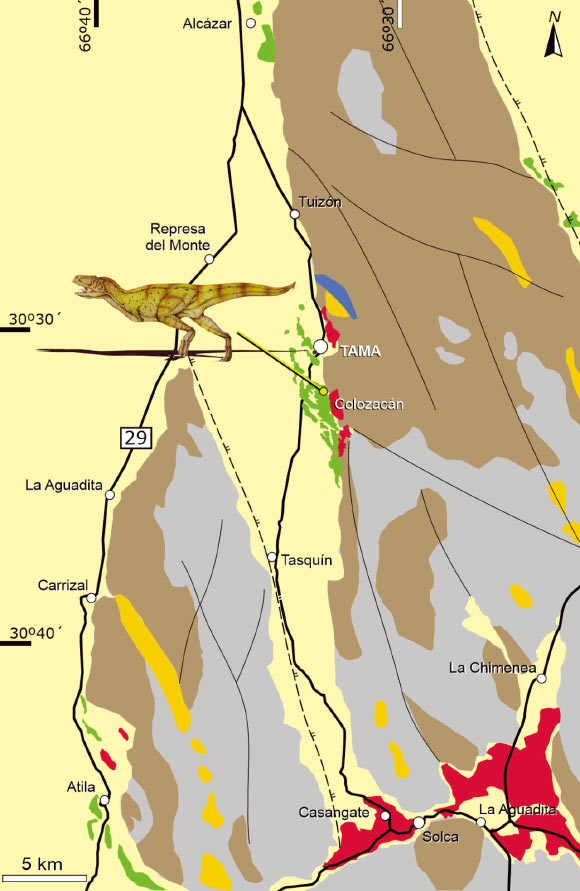A new genus and species of abelisaurid theropod dinosaur has been discovered by a team of paleontologists from Argentina, Brazil and the United Kingdom.

Geological map showing the location of Vitosaura colozacani in the Los Llanos Formation, La Rioja Province, Argentina. Image credit: Jiménez Velandia et al., doi: 10.5710/AMGH.24.09.2025.3653.
The newly-discovered dinosaur species, Vitosaura colozacani, roamed our planet around 80 million years ago (Late Cretaceous epoch).
The ancient creature belongs to Abelisauridae, a group of predatory dinosaurs that thrived mainly in Gondwana during the Cretaceous period.
The fossil record of this group is currently represented by more than 25 species, and their most complete and abundant records are from the Argentinean Patagonia.
“Abelisauridae is a clade of ceratosaurian theropods erected in 1985 and characterized by the presence of a robust, short, and tall skull, well-ornamented maxillae and frontals, a highly pneumatized axial skeleton, and reduced forelimbs,” said Dr. Harold Jiménez Velandia of CONICET and his colleagues.
“The discovery of multiple abelisaurid species over the last few decades, mainly in Gondwanan landmasses, has significantly enhanced our understanding of this group of theropods.”
“Abelisauridae was the dominant clade of theropod dinosaurs during the Cretaceous in Gondwana, with numerous records in northern Africa and Indo-Madagascar, and they also reached Laurasia in what is current-day central Europe.”
“Beyond these records, the group was astonishingly successful in South America, with a very abundant fossil record.”
The fossilized bones of Vitosaura colozacani were excavated during field trips in 2009 and 2010, at the Tama locality of the Los Llanos Formation in La Rioja Province, northwestern Argentina.
“The theropod remains are represented by a first dorsal centrum, a second dorsal vertebra, a partial sacrum, left ilium, pubis and ischium, and other indeterminate elements,” the paleontologists said.
“The specimens were associated with several titanosaur postcranial remains.”
Vitosaura colozacani was a medium-sized abelisaurid with a total length between 4.5-5.5 m (15-18 feet).
The species lived in a seasonal, semi-arid, and drained environment, with average annual rainfall fluctuating between 230 and 450 mm per year.
“The discovery of Vitosaura colozacani in the Campanian beds of the Los Llanos Formation in La Rioja Province expands the geographic distribution of abelisaurids, but the implications of the new species are limited by its incompleteness and the state of flux that we note in multiple, recent phylogenetic analyses focused on the abelisaurid interrelationships,” the researchers said.
“We consider that it is necessary to carry out new studies to improve the topological robustness of the phylogeny of Abelisauridae and discover new material assignable to Vitosaura colozacani to test more robustly the phylogenetic hypotheses discussed in our study.”
The findings were published October 2, 2025 in the journal Ameghiniana.
_____
Harold Jiménez Velandia et al. 2025. A new Late Cretaceous abelisaurid species from La Rioja Province, northwestern Argentina. Ameghiniana 62 (5): 1-23; doi: 10.5710/AMGH.24.09.2025.3653







